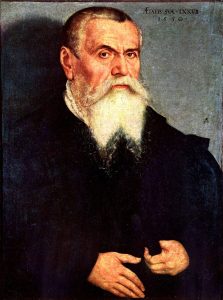A famous painter
 Lucas Cranach the Elder (1427-1553) © Wikipedia Commons (The Yorck Project)
Lucas Cranach the Elder (1427-1553) © Wikipedia Commons (The Yorck Project)
He was born in Kronach in Upper Franconia in 1472 and probably learned painting and engraving in Vienna, Austria. He quickly became famous thanks to his highly intense religious paintings, such as the Martyrdom of Saint Katherine in 1506. Many of his works were on religious themes, but he also dealt with lay themes, mostly mythological. They display, among other qualities, a renewed aspect of the nude, for instance his famous Venus dated 1529 and the Three Graces, both at the Louvre Museum in Paris.
In 1502 he was called to the court of Saxony by Frederick II the Wise, prince Elector of Saxony and settled in Wittenberg. Until he died in 1553, he was the official painter at the court of Saxony. Besides the portraits of reigning princes he was appointed to make, Cranach also painted one of Charles V. His occupation made him a public figure in Wittenberg. He set up his workshop there, became the owner of a pharmacy, which enabled him to develop lucrative activities; he also bought a printing shop, the very one where Luther has his theses and later his translations of the Bible printed. He was also asked to become member of the City Council and was the burgomaster at different times.
Friendship with Luther
 © Collection privée
© Collection privée
Upon the posting of the 95 theses in Wittenberg, Cranach took sides with Luther. They instantly became friends and never failed to help each other: Luther was the godfather of Cranach’s daughter and Cranach was Catherine Bora’s witness when she married Luther. Other evidence is a series of portraits of Luther and his loved ones, notably of his daughter Magdalena who died when she was 7, and can be seen at the Louvre. Paintings on wood or engravings over time and circumstances also bear witness to their friendship, for instance in 1519 Cranach portrays Luther as a focused and friendly young man in a private collection in Brussels; in 1520 an engraving shows a tonsured Augustinian monk at the Bibliothèque Nationale de France (French National Library); in 1522 he portrayed Luther with a beard he grew so as not to be recognised at the Bibliothèque Royale de Belgique (Belgian Royal Library); in 1525 he painted Luther with his wife.
Cranach supported Luther’s reformative work by developing an iconography illustrating the main theological arguments of the Reformation. Such as the engravings illustrating biblical scenes and celebrating Sola scriptura. But also altarpieces like the one in Saint Mary’s Church in Wittenberg showing the main liturgical modifications of the Reformation; the importance of the sermon and the way the Last Supper was celebrated. In 1529, one in Prague portrayed Law and Grace. In Weimar at Pater und Paulkirche, he displayed the theme of justification through faith. After Cranach died the altarpiece was completed by his son Hans Cranach, called Cranach the Younger (1556-1586). In both pieces Luther, as well as Cranach, were portrayed.
The place of images in the history of the Reformation
After the Council of Trent and the importance it gave to religious painting in order to prevent the spreading of the Reformation, a degree of mistrust towards the image developed in Reformation circles. Calvin himself was definitely opposed to any representation of biblical scenes. Cranach’s works, like those of Rembrandt, showed that mistrust can be overcome. And one must acknowledge that the Counter Reform was the source of outstanding works.